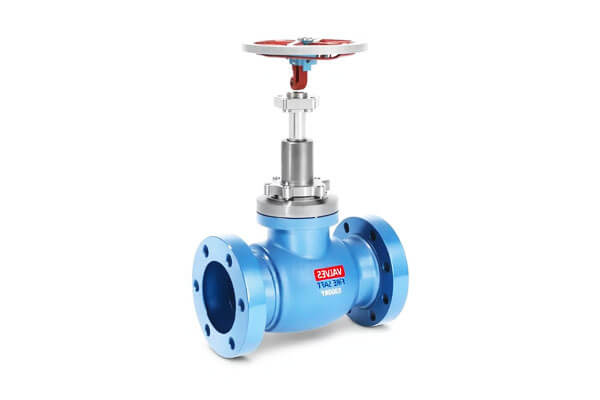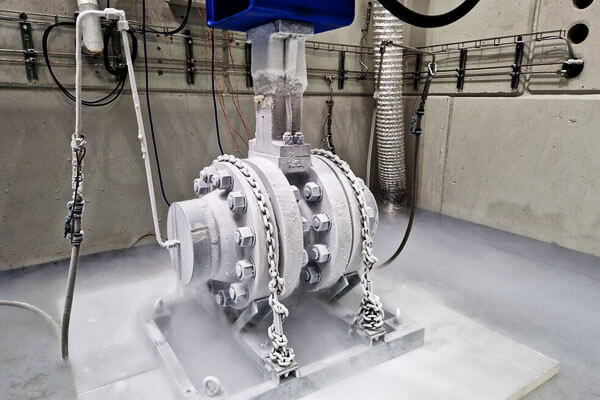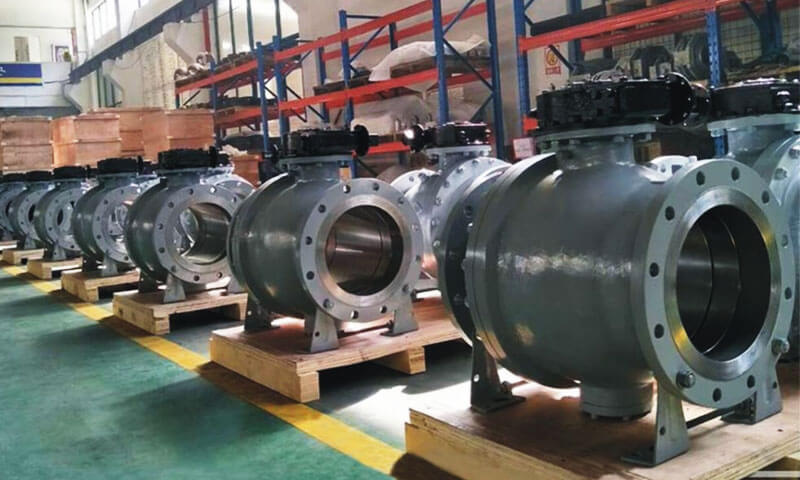Та Американдық ұлттық стандарттар институты (Ansi) клапан дизайнының әртүрлі аспектілерін реттеуге бағытталған клапан стандарттарының толық жиынтығын құрды, Өндіріс, сынау, және орнату.
Бұл стандарттар жоғары сапалы қамтамасыз етуде маңызды, Әр түрлі өндірушілердің өнімдері бойынша дәйекті және үйлесімділік, Инженерлік тәжірибелерде салалар бойынша біркелкілікті арттыру.
1. ANSI клапан стандарттарының фон және эволюциясы
Құрылған 1918, ANSI американдық ұлттық стандарттарды әзірлеу үшін үйлестіруші орган ретінде қызмет етеді.
Клум-инженерия саласында, ANSI құрылымдық және дамып келе жатқан стандарттау жүйесін қалыптастыруда маңызды рөл атқарды.
Бастапқыда отандық өндірістік қажеттіліктер мен эмпирикалық тәжірибеге негізделген,
ANSI клапанының стандарттары әлемдік сауда және технологиялық жетістіктердің өсу күрделілігіне біртіндеп бейімделді.
Халықаралық инженерлік қоғамдастық стандарттарды үйлестіруге көшкен сайын,
ANSI сияқты денелермен белсенді жұмыс жасады Халықаралық стандарттау жөніндегі ұйым (Исо) және Американдық механикалық инженерлер қоғамы (Asme).
Бұл ANSI клапанының стандарттарының жаһандық қабылдауы мен қолданылуын едәуір жақсартты, әсіресе шекаралық инфрақұрылым жобаларында.
2. ANSI клапанының стандартты жүйесі: Интеграцияланған шеңбер
Бірыңғай бірыңғай код болып табылатын, ANSI клапанының стандарттары көптеген өзара байланысты құжаттардан тұратын кең жүйені құрайды.
Көбісі ASME стандарттарымен тығыз байланысты, әсіресе олар B16 сериясы, сияқты:
ANSI клапанының стандарттарына шолу
| Санат | Стандарт | Тақырып / Түсіндірме |
|---|---|---|
| Дизайн стандарттары | ANSI B16.34 | Клапандар - фланеген, Бұрандалы, және дәнекерлеу соңы: Қысым-температуралық рейтингтерді қамтиды, Өлшемдер, Қабырғалы қалыңдығы, және тестілеу. |
| ANSI B16.5 | Құбырлар фланецтері және фланецті фитингтер: Өлшемдерді анықтайды, төзімділік, Фланецке арналған қысым-температура рейтингі. | |
| Материалдық стандарттар | ANSI B16.24 | Қола клапандары: Қоладан құймаларына арналған материалдың құрамы мен өнімділігін анықтайды. |
| В16.34-те сілтеме жасады | Көміртекті болаттан жасалған материалдық талаптарды қамтиды, Тот баспайтын болат, және арнайы қорытпалар. | |
| Өндіріс процесі | ANSI / AWS D1.1 | Құрылымдық дәнекерлеу коды - болат: Клапанды өндіріс үшін дәнекерлеу тәжірибесін басқарады. |
| Құю & Өте өңдеу | Кастингті қамтиды, соғу, Термиялық өңдеу, өңдеу, және ақауларды тексеру рәсімдері. | |
Тексеру & Сынау |
ANSI B16.104 | Клапанның ағып кетуі: Клапанның ағып кетуі және қолайлы шектеулер анықтайды. |
| В16.34-те сілтеме жасады | Гидростатикалық қабықшаны сынауды және көрсетілген қысымдар бойынша орындық тестілеуді қажет етеді. | |
| Қысым-температуралық рейтингтер | ANSI B16.34 Қосымшалар | Әр түрлі материалдар мен клапандар үшін қысымды қысымды диаграммалармен қамтамасыз етеді. |
| Орнату стандарттары | ANSI B31.1 / B31.3 | Қуат және процестер құбырлары кодтары: Клапандарға арналған құбыр жүйесін біріктіруге қойылатын талаптар. |
| Өзара әрекеттестік стандарттары | ANSI / ISA 75.05.01 | Басқару клапаны терминологиясы: Бақылау клапандары номенклатурасы мен техникалық сипаттамаларын стандарттайды. |
| Өлшемді үйлесімділік | ANSI B16.10 | Бетке бетпе-бет және ақырғы клапандар өлшемдері: Өлшемді консистенцияны қамтамасыз етеді. |
3. ANSI клапан стандарттарының негізгі категориялары
Клапанның дизайнерлік стандарттары
ANSI / ASME B16.34 фланецтелген болат клапандар үшін дизайн ережелерінің өзегінде тұрады, бұрандалы, немесе вагондар аяқталады.
Ол дене өлшемдеріне қойылатын нақты талаптарды қояды, PONNET құрылысы, Сабақ конфигурациясы, Әр түрлі қызмет жағдайларында функционалды тұтастықты қамтамасыз ету үшін диский геометриясы.
Мысалы, ол әр қысым температурасы бойынша класс үшін ең аз қабырға қалыңдығына ие болады,
Сыныпқа кепілдік беру 600 Клапан жұмыс қысымы жеткен кезде оның күші мен ағып кетуін сақтайды 1,440 psi at 100 ° F.
Сол уақытта, ANSI / ASME B16.5 фланецтер лшемдерін және құбырлар фланецтері мен фланецті фитингтер үшін қысымды температура рейтингін анықтайды (½ «-24» NPS),
Қауіпсіз құбыр компоненттері бар клапан фланецтерінің жұптастырылуын қамтамасыз ету, Ағып кетусіз байланыс.

Клапанның материалдық стандарттары
ANSI стандарттары клапан компоненттерінде қолданылатын қорытпаларды қатаң түрде реттейді.
ANSI B16.24 бойынша, Қола құймалары қатаң химиялық құрамға және механикалық меншік шектеріне сәйкес келуі керек.
Сықылды, ANSI / ASME B16.34 көміртекті болат бағаларынан бастап, сұйықтық ортасына негізделген коррозияға төзімді және легирленген болаттарға арналған рұқсат етілген болаттарға категориялар, температура, және қысым.
Жоғары коррозиялық немесе жоғары температуралы ортада, Инженерлер, әдетте, дуплексті тот баспайтын болаттан немесе никель-негіз қорытпаларын таңдаңыз, Қандай клапанның қызмет ету мерзімін ұзартуы мүмкін 50% Салыстырмалы материалдармен салыстырғанда.
Клапанды өндіріс процестерінің стандарттары
Өндірушілер өндірістің әр сатысында қатаң ANSI нұсқауларын ұстануы керек, соғу, өңдеу, және дәнекерлеу - клапанның тұтастығы мен өнімділігіне кепілдік беру.
Бірінші, ішінде кастинг, Төртөгісті анықтау үшін негіздеме ультрадыбыстық немесе радиографиялық тексерулер жүргізеді, кішірейту, және қосу, ақаулардың тарифтерін азайту 20%.
Үстіне, Олар температура мен салқындату тарифтерін басқарады, әдетте 1,200 ° C және 1,350 ° C - біркелкі микроқұрылымға қол жеткізу және ыстық көздің алдын алу үшін.
ANSI Максималды ақау өлшемдері мен мандаттарды, бұдан артық емес 5% кастингтің көлденең қимасында қосалқы табалдақтық кемшіліктер болуы мүмкін, Әрбір клапанның денесін механикалық беріктік талаптарына сай қамтамасыз ету.
Ішінде өңдеу фаза, FABISARS Жабу беттеріндегі ± 0,1 мм-ден асатын CNC орталықтарын жұмыс істейді.
Қосымша, олар әрлеуді әрлеуді орындайды 50 бөліктер, өлшемді ауытқуларды сақтау 0.05 мм.
Бұл басқару элементтері ағып кету жолдарын азайтады және ансидің беттік қабаттарымен тураланады - әдетте 1.6 мкм Ра сыни тығыздағыш беттерде.
Соңында, Клапан өндірушілері орындалады дәнекерлеу ANSI / AWS бойынша D1.1 протоколдары,
100-200 ° C температурада алдын-ала жылу және дәнекерлеуден кейінгі термиялық өңдеу, ал қалдық күйзелістерді жеңілдету үшін легірленген болаттар үшін 600-650 ° C температурада.
Дәнекерлеушілер иілу арқылы рәсімдерді талап етеді, созық, және соққы сынақтары -29 ° C, Әрбір бірлескен әр түйіскен немесе одан асатынын тексеру 90% негізгі металдардың беріктігі.
Осы егжей-тегжейлі технологиялық стандарттар бойынша, Өндірушілер клапандарды ерекше беріктігімен жеткізеді, Ағып кетуге төзімділік, және қызмет көрсету мерзімі.
Тексеру және тестілеу стандарттары
ANSI / ASME B16.104 жан-жақты тексеру және тестілеу әдістерін ұсынады, бұл клапанның қызметке дайындығын тексереді.
Ол қабықтың сынақтарын қажет етеді 1.5 Клапанның бағаланған қысымы - сондықтан класс 300 клапан (705 PSI рейтингі) шыдай алады 1,058 PSI гидростатикалық сынағы,
Әр түрлі клапан түрлері үшін ағып кетуге рұқсат етілген максималды ағып кету ставкалары бар отырғыштарды сынауды анықтайды.
Осы қатаң сынақ шарттарын және ұзақтықтарын орындау арқылы, ANSI олардың рейтингтік қойылым шектеріне жиналуға тек қана клапандармен жұмыс істеуді қамтамасыз етеді, далалық ақаулар мен техникалық қызмет көрсету шығындарын күрт төмендетеді.
4. ANSI-дің негізгі стандарттарына егжей-тегжейлі сараптама
ANSI өзінің ең ықпалды клапан стандарттарын төрт флагмандық құжаттамаға енгізеді.
Әрқайсысы нақты инженерлік доменге жүгінеді, және бірге олар дизайнға бағыттайтын үйлесімді жүйе құрады, Өндіріс, және қолдану.

ANSI / ASME B16.5 - Құбырлар фланецтері және фланецті фитингтер
Бірінші, B16.5 Номиналды құбырлардың өлшемдері мен рейтингтерін стандартты (Ұлттық желі) «24-ке дейін» ½ бастап.
Ол алты қысым класын анықтайды - 150, 300, 400, 600, 900, және 1500-әрқайсысы белгілі бір қысым температурасының қисық сызығына байланған.
Мысалы, сынып 150 12 «NPS сызығындағы фланецті ұстап тұруы керек 285 psi at 100 ° F, Сабақ кезінде 900 сол мөлшерде жетеді 1,440 пси.
Стандарт сонымен қатар болт шеңберінің диаметріне төзімділікті көрсетеді (Flanges ≥8 үшін ± 1 мм »), Бет әрлеу (125-250 мкин олар), және тығыздағыш түрлері (көтерілген бет, жалпақ бет, және қоңырау типіндегі буын).
Осы параметрлерді орындау арқылы, B16.5 кез-келген клапан фланецінің ағып кетуі үшін сәйкес құбырлар фланецтерімен жұптасуға кепілдік береді, Механикалық түрде дыбыстық қосылыстар.
ANSI / ASME B16.10 - бетпе-бет және соңғы өлшемдер
Сосын, B16.10 Әр түрлі клапан түрлері үшін өлшемді стандарттарды тағайындайды,
оның ішінде қақпа, жер шары, доп, көбелек, және клапандарды тексеріңіз, Бетпе-бет және бетпе-бет және орталық ұзындығы өндірушілерге сәйкес келеді.
Мысалы, 6 «класс 300 Қақпа клапаны дәл өлшеуі керек 406 М.М. Бетке бетпе-бет, төзімділік ± 3 мм.
Бұл біртектілік өрісті ауыстыруды жеңілдетеді: Инженерлер ішкі құбырларды модификацияланатын тозған клапанды ауыстыра алады.
B16.10 сонымен қатар фланецке жасалған ұштар мен қабықтың өлшемдерін қамтиды, Қолданыстағы жүйелерге үздіксіз клапандарға сәйкес келу.
ANSI / ASME B16.34 - клапан дизайны, Материалдар, және рейтингтер
Сонымен қатар, B16.34 Дизайн критерийлерін біріктіреді, Материалдық топтық жіктеулер, Мылтықпен жасалған болат клапандарға арналған қысым-температура рейтингі, бұрандалы, және бөкселер аяқталады.
Ол көміртекті болаттардан рұқсат етілген қорытпалар тізімі берілген (ASTM A216 WCB) жоғары никель қорытпаларына (ASTM A351 CF8M)- және әрбір материал тобының нөмірін тағайындайды.
Бұл топтар тікелей қысым-температуралық механизмдерге бөлінеді; мысалы, Топтағы тот баспайтын болаттан жасалған клапан 5 толуы керек 1,000 psi at 100 ° F 500 psi at 750 ° F.
B16.34 Қосымша мандаттар Shell-қалыңдығы есептеулер, Саңылауларды арматуралау талаптары, және гидростатикалық сынақ процедуралары,
Осылайша, бұл клапандар импульсация немесе циклдік жүктемелердің құрылымдық тұтастығын сақтауды қамтамасыз етеді.
ANSI / ASME B16.47 - Ірі диаметрлі фланецтер
Соңында, B16.47 фланецті стандарттарды үлкен диаметрлерге дейін созады (26«-60» NPS), Сыйымдылығы жоғары құбырлардағы ерекше кернеулерді шешу.
Ол A және серия сериясына бөлінеді, әрқайсысы болтпен, диаметрі және қалыңдығы профильдері бар.
36 «класс үшін 300 фланец, Сегіз 1⅜ «болттарға қоңырау шалыңыз, ал В сериясы он екі 1¼ «болттарды қолданады.
Стандарт сонымен қатар термиялық және қысым циклдарының астындағы тығыздағыштардың экструзиясының алдын алу үшін минималды фланецті қаттылықты көздейді.
Осы сипаттамаларды кодтау арқылы, B16.47 ірі бордақылау клапандары мен құбырлардың құрамдас бөліктеріне мұнайхимиялық деңгейде сенімді болатынына кепілдік береді, Сұйытылайды, және электр қуатын өндіру.
5. Қысым рейтингі және температуралық жіктеулер
Клапанның қысым клалары-150, 300, 600, 900, 1500, және 2500 - рұқсат етілген жұмыс қысымын анықтаңыз (Мавф) анықтамалық температурада 100 ° F (38 ° °).
Мысалы, сынып 150 клапан әдетте болады 285 пси, Сабақ кезінде 600 Клапанмен бірге 1,440 PSI бірдей температурада.

Дегенмен, Қызмет температурасы көтерілген сайын, Материалдың күші төмендейді және сәйкесінше азайту керек.
Суреттеу, Сыныптағы көміртекті болаттан жасалған клапанды қарастырыңыз 300:
- -Та 100 ° F, ол қарсы 740 пси.
- -Та 500 ° F, оның мавы шамамен төмендеді 370 PSI-дәл жартысы қоршаған орта рейтингінде.
- Ар жағында 800 ° F, Рұқсат етілетін қысым төменде 200 пси, жоғары температуралы қорытпаларды пайдалану немесе қызмет көрсетудің төмендеуі қажет.
ANSI қысыммен температуралық кестелер әр материалдық топқа арналған егжей-тегжейлі қисықтарды ұсынады.
Тот баспайтын болат үшін (Топтау 5 B16.34-те), мави 100 ° F болып табылады 1,000 Сыныпқа арналған PSI 600 бірақ азаяды 650 psi at 400 ° F және одан 500 psi at 750 ° F.
Осы кестелерден кеңес алу арқылы, Инженерлер клапанның рейтингтерін жүйелік жағдайда дәл сәйкестендіре алады, Осылайша, компоненттерді ұзартудан және кеңейтуден аулақ болу керек.
Үстіне, ANSI стандарттары ең аз дизайн маржасын ұсынады: Клапандар гидростатикалық қабықша сынақтардан өтуі керек 1.5 × Мавп және отырғыштан шығару сынақтары 1.1 × mawp.
Бұл қауіпсіздік буфері температураға ұшыратылған беріктікті азайту кезінде де сенімді жұмысты қамтамасыз етеді, сайып келгенде, өсімдіктердің тұтастығын сақтап, жоспарланбаған ұйқысыздықты азайту.
6. Басқа стандарттармен байланыс
ANSI клапанының стандарттары біріктіріңіз Asme Механикалық инженерлік базаны қалыптастыру үшін кодтар.
Ақиқатында, үстінде 80% ANSI B16 сериялары B16.34 және ASME VIII бөлімі сияқты ASME сипаттамаларымен тікелей тураланады, мысалы, құрамында қысым бар компоненттер ұқсас стресстен алшақтатады.
, Сорт, Дизайнерлер бірыңғай анықтамадан пайда әкеледі: Олар қысымсыз есептеулер мен ANSI / ANSI / ANSI / ANSI / ANSI / ASME саңылама талаптарын салыстырып, вальмалар мен рейтингтер үшін.
Бұл синергия инженерлік қателерді есептейді 25% және жобалық кестелерді орташа есеппен екі аптаға дейін жеделдетеді.
Үстіне, ANSI бірлесіп жұмыс істейді Американдық Мұнай институты (Апи) Салалық талаптарға жауап беру.
Мысалы, Апи 600 Қысқы жүйелерге арналған қақпалық клапанға қойылатын талаптар ANSI / ASME B16.34 қосымша металлургиямен және өрт қауіпсіз сынау сызықтарымен.
Болғандықтан, Мұнай-газ операторлары көбінесе өлшемді және тиімділік үшін дуальды сәйкестік-ансиді ұсынады,
және сектордың мақсатты беріктігіне арналған API, сол арқылы жету 40% Коррозиялық қызметке аз клапандарды ауыстыру.
Соңында, ANSI тұрақты диалогты жүргізеді Исо жіне -Да (Еуропалық нормалар) Халықаралық сауда тәжірибесін үйлестіру.
Байланыс комитеттері арқылы, ANSI ондаған ISO клапанының стандарттарынан көп жарияланған немесе сілтеме жасаған, мысалы, ИСО 5208 ағып жатқан сынақ үшін,
осылайша 65% жаһандық жобалар ANSI немесе ISO белгілерін алмастыра алады.
Бұл жаһандық туралау өндірушілерді өндірушілерді тауарлық-материалдық қорларды жеңілдетуге мүмкіндік береді және инженерлік фирмаларға минималды стандартты жұмысымен қамтамасыз етіледі.
7. Әлемдік сауда және инженериядағы өтініш
Әлемдік стандарттау және нарықты тану
ANSI клапанының стандарттары халықаралық нарықтарда кеңінен танылады, әсіресе май сияқты салаларда & газ, Электр қуатын өндіру, Суды тазарту, және мұнайхимиялары.
Көптеген жаһандық жобалар сапаны қамтамасыз ету үшін ANSI үйлесімді клапандарын көрсетеді, орындау, және пайдалану жағдайындағы қауіпсіздік.
Олардың кең таралған қабылдауы жеткізушілер арасындағы тығыз байланысты жеңілдетеді, инженерлер, және реттеушілер.
Трансшекаралық сауданы жеңілдету
Жаһандық сатып алуларда, ANSI стандарттары ортақ техникалық тіл ретінде әрекет етеді.
Мысалы, ANSI B16.34 (Клапан дизайны) және ANSI B16.5 (фланец өлшемдері) көбінесе трансшекаралық инфрақұрылым келісімшарттарында талап етіледі.
Бұл стандарттау орнату кезінде сәйкессіздіктің қаупін азайтады және көпұлтты жеткізілім тізбегі бойынша үйлесімділікті жақсартады.
Техникалық кедергілерді азайту
ANSI стандарттары ИСО және ХЭК сияқты халықаралық ұйымдармен туралау арқылы сауда-саттыққа техникалық кедергілерді азайтуға көмектеседі.
Болғандықтан, ANSI қысым кластары мен ISO PN рейтингтері арасында үйлесімділіктің өсуі байқалады.
Бұл үйлестірулер өңірлер бойынша клапандарды алмастыруды және алмастырғышты оңай ауыстыруға және өзара алмастырады, Жобаны жеңілдету және жобаны азайту.
Инженерлік жобалау және құралдарды жақсарту
Инженерлік тұрғыдан, ANSI клапанының стандарттары материалдық іріктеу үшін сенімді сілтемелер ұсынады, қысым рейтингі, және өлшемді дизайн.
Инженерлер қауіпсіз және тиімді клапанды таңдау үшін осы стандарттарға сүйенеді.
Қосымша, Көптеген CAD және модельдеу құралдары (E.Г., Цезарь II, AutoCAD зауыты 3D) ANSI сипаттамаларын қосу, Дизайн процесін дәл және стандартталған ету.
Жобаның жаһандық тиімділігін қолдау
Техникалық сипаттамалар мен тестілеу әдістері бойынша біркелкілікті арттыру арқылы, ANSI клапанының стандарттары жаһандық жобаларға кесте бойынша және бюджет аясында болуға көмектеседі.
Олар қайталанған тексеру қажеттілігін төмендетеді, Нормативтік сәйкестікті жеңілдету, Әр түрлі өндірушілердің клапандарының клапандарының бірдей қойылымның көрсеткіштеріне сәйкес келетіндігін қамтамасыз етіңіз.
8. Болашақ даму және технологиялық интеграция
Smart клапан технологияларын қабылдау
Өнеркәсіптік автоматтандыру үдеткен сайын, ANSI клапанының стандарттары сенсорлармен жабдықталған ақылды клапандарға арналған нұсқаулықтарды қамтиды деп күтілуде, Жетекеткіштер, және нақты уақыттағы мониторинг жүйелері.
Бұл интеллектуалды клапандар болжамды техникалық қызмет көрсетуде маңызды рөл атқарады, Өнімді оңтайландыру, және қашықтан диагностика.
ANSI стандарттарының болашақ түзетулері байланыс хаттамаларын қамтуы мүмкін (E.Г., Тор, Profibius, немесе modbus) Өндірістік бақылау жүйелерімен біркелкі интеграцияны қамтамасыз ету үшін киберқауіпсіздік аспектілері.
Тұрақтылық және экологиялық көрсеткіштер
Жаһандық экологиялық проблемаларға жауап ретінде, ANSI клапан стандарттарының дамуы тұрақты дамуға бағытталған.
Бұл клапанды герметизациялау жүйелеріне арналған эмиссиялардың қаттылығын бақылауды қамтиды (мысалы, қашқын шығарындылар сияқты), Экологиялық таза материалдарды қолдану, ағынды бақылаудың жақсартылған тиімділігі.
Стандарттар жасыл инженерлік тәжірибелермен және халықаралық климаттық мақсаттармен ерекшеленуі мүмкін.
Жетілдірілген материалдар және өндірістік әдістер
Тот баспайтын болаттар сияқты озық материалдарды қабылдау, Коррозияға қарсы қорытпалар, Композиттер клапан өндірісінің эволюциясын жүргізеді.
ANSI стандарттары осы материалдарды жою үшін кеңейтіледі деп күтілуде, әсіресе жоғары қысымды және жоғары температуралы қосымшалар үшін.
Қосымша, Дамушы өндіріс техникасы, мысалы, қоспалар өндірісі (3D Басып шығару) және озық беттік емдеу - материалдық біліктілік және тестілеуге арналған жаңа нұсқаулар қажет етеді.
Сандық стандарттау және қол жетімділік
Сандық дәуірде, ANSI стандарттары сандық платформалар мен интерактивті құралдар арқылы қол жетімді бола бастайды.
Болашақ дамуларда бұлтқа негізделген стандартты кітапханалар кіруі мүмкін, Клапан компоненттеріне арналған сандық егіздер, және құрылыс модельдеуімен интеграция (Дая )фан) жүйелер.
Бұл жаңалықтар жобалық тиімділікті арттырады, Сәйкестік тексеру, Күрделі инженерлік жүйелердегі клапандарды өмірлік циклді басқару.
Әлемдік үйлестіру жұмыстары
ANSI ISO және IEC сияқты басқа халықаралық стандарттау органдарымен көбірек жұмыс істейді.
Болашақтағы өзгерістерді қайта құру және үйлестіруден арылуға және жаһандық өзара әрекеттесуге ықпал етуге мүмкіндік береді.
Бұл үрдіс аймақтық және халықаралық техникалық шарттар арасындағы қақтығыстарды азайту арқылы көп ұлтты жобаларға пайдалы болады.
9. Қорытынды
Та ANSI қауіпсіздік стандарты Жыртқыш клапан инженериясына арналған негіз болып табылады, Өнімділіктің дәйектілігін қамтамасыз ету, қауіпсіздік, және өндірістік жүйелердегі өзара әрекеттесу.
Оны ASME-мен теңестіру, Исо, және API стандарттары одан әрі өз жаһандық өзектілігін арттырады.
Салалар, өйткені таза энергия мен ақылды инфрақұрылымға көшу, ANSI стандарттары дамуды жалғастырады, Инженерлік тұтастықты сақтау кезінде инновацияны қолдау.
-Та Осы, Біз тек ANSI клапанының стандарттарын ұстанбаймыз - біз дәлдікті құрамыз, орындау, Біз жасайтын әр клапанға жан тыныштығы.
Сізге талап етілетін қосымшалар мен премиум-бағаны үшін арнайы шешімдер қажет пе Клапан компоненттері бұл жаһандық стандарттарға сәйкес келеді, Біздің команда жеткізуге дайын.
Бүгін бізбен хабарласыңыз және тәжірибеңіз Осы айырма.



